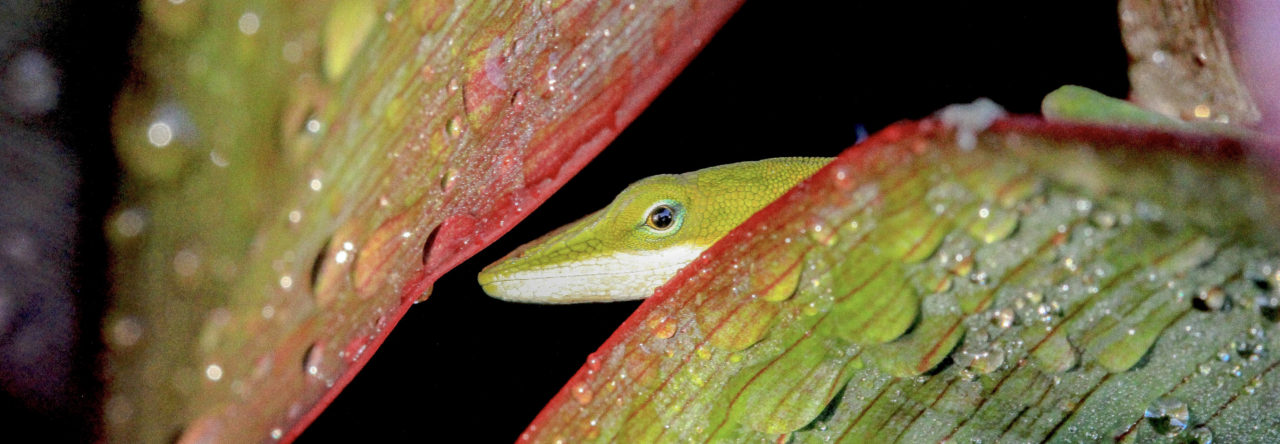
Anolis pentaprion taxiing down the runway on a canopy tower at the La Selva Biological Station in Costa Rica. Photo by Vinicio Paniagua.
 Draco, the flying dragon, has borrowed an anole dewlap, so it’s only proper that anoles return the favor by developing gliding capabilities. It’s been long rumored that Anolis pentaprion, a twig anole from Central America, will launch itself off of perches in canopy and glide away, but now Steve Overbauer, Vinicio Paniagua, Craig Guyer and Mo Donnelly have documented just that in an interesting herpetological natural history note that appeared in the last issue of last year’s volume of Herp Review (Vol. 44, pp. 677-678). Here’s what they have to say:
Draco, the flying dragon, has borrowed an anole dewlap, so it’s only proper that anoles return the favor by developing gliding capabilities. It’s been long rumored that Anolis pentaprion, a twig anole from Central America, will launch itself off of perches in canopy and glide away, but now Steve Overbauer, Vinicio Paniagua, Craig Guyer and Mo Donnelly have documented just that in an interesting herpetological natural history note that appeared in the last issue of last year’s volume of Herp Review (Vol. 44, pp. 677-678). Here’s what they have to say:
“Lizards with gliding or directed aerial descent behaviors are well known from the Old World Tropics (e.g., Draco, Ptychozoon), and snakes and frogs exhibiting these behaviors are found both in the Old and New World Tropics (Dudley et al. 2007. Annu. Rev. Ecol. Evol. Syst. 38:179–201). However, lizards showing directed aerial descent have not been reported from the New World Tropics. Here we report on directed aerial descent capability and behavior in Norops pentaprion, a canopy lizard from eastern Costa Rica, southern Nicaragua, and western Panama (Köhler 2010. Zootaxa 2354:1–18).
The initial discovery of this behavior in N. pentaprion was serendipitous in July 2001 when an individual was captured on a walk-up meteorological tower at canopy level (~ 25 m) at La Selva Biological Station in the Atlantic lowlands of Costa Rica. After identification, the animal was returned to the original location on the tower, but upon release to a horizontal tower brace, it executed a controlled aerial descent to a tree in the distance below. Individuals of N. pentaprion have been occasionally observed on our meteorological towers subsequent to our first observation of directed aerial descent. The lizards are typically at canopy level but are sometimes found well above the canopy on the highest levels of the towers (up to 42 m). While the typical response of N. pentaprion to the presence of personnel on the tower is to race down the tower or hide on the opposite side of vertical supports, the animals will occasionally jump from the tower to escape when approached. Since 2001 we have observed directed aerial descent by N. pentaprion from canopy towers on several occasions. In at least two instances the lizard landed at lower levels on the tower, but in other occurrences they covered substantial distance to adjacent trees including aerial rotations of near 180º. During more than one observation, animals appeared to glide with near-horizontal trajectories towards termination of the descent. Similar to some snakes, frogs, lizards, and ants showing directed aerial descent, N. pentaprion does not have strongly specialized features associated with gliding behavior such as skin flaps, skin extensions, or webbed feet. Norops pentaprion has a relatively flattened head and wide body. During aerial descent this lizard proceeds headfirst, with limbs partially extended and the body strongly flattened, a position that may take advantage of regions of relatively loose skin along the sides of the body (Guyer and Donnelly 2005. Amphibians and Reptiles of La Selva, Costa Rica, and the Caribbean Slope, Univ. California Press, Berkeley, California. 299 pp.).
At La Selva Biological Station this species is uncommon in the understory and is usually found on trees limbs. Norops pentaprion is a member of a closely-related group of anoline lizards subjected to a recent analysis of morphology and morphometrics (Köhler, op. cit.); these related taxa share similar body size characteristics with N. pentaprion and are frequently arboreal. Future observations of some of these species may result in the discovery of similar directed-aerial descent behavior. Canopy pioneer Donald Perry reported lizards with a rose dewlap parachuting between trees in the canopy in Costa Rican forests (Perry 1986. Life Above the Jungle Floor, Simon and Schuster, Inc. New York, New York. 170 pp.), but the species was not identified. In their description of Norops pentaprion, Guyer and Donnelly (op. cit.) indicated that parachuting behavior likely occurs in this species on the basis of our initial observations and those of Perry. Our repeated observations verify directed aerial descent in this species and confirm that the lizard observed by Perry was N. pentaprion, the only lizard in the region with magenta dewlap coloration.”





 What better way to celebrate moving your clock forward than getting that anole watch–available in five ecomorphs–that you’ve been coveting. Pop on over to
What better way to celebrate moving your clock forward than getting that anole watch–available in five ecomorphs–that you’ve been coveting. Pop on over to 



